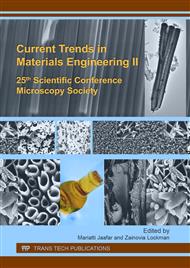p.116
p.120
p.124
p.128
p.132
p.136
p.140
p.144
p.148
Effect of Calcination Temperatures on Phase Transformation and Stability of β-Tricalcium Phosphate Powder Synthesized by a Wet Precipitation Method
Abstract:
Beta-tricalcium phosphate (β-TCP) was never synthesized directly using an aqueous method. As-precipitated powder from a wet chemical method needs to undergo a heat-treatment process (or calcination) to enable the intermediate phase (s) to be transformed into single-phase TCP. In this work, calcium hydroxide, (Ca (OH)2), and phosphoric acid, (H3PO4), were mixed as the precursor materials with a Ca/P ratio of 1.5,. The mixture was stirred at a fixed stirring speed of 200 rpm and a stirring duration of 2 hours. The precipitate thus obtained was filtered and dried overnight before being tested by differential scanning calorimetry and thermogravimetry (DSC/TG) up to 1300°C for thermal behaviour upon firing. The powders were then calcined at various temperatures (500°C, 700°C, 900°C 1000°C, 1100°C, 1200°C and 1300°C) for a duration of 2 hours. The calcined powders obtained were analysed by x-ray diffraction (XRD) to determine the transformation of phases. Monetite and hydroxyapatite were the phases detected after calcination at 500°C and 700°C, whilst at a temperature of 900°C up to 1300°C, only a single phase β-TCP was observed. Microstructural observation by scanning electron microscopy (SEM) was conducted on the β-TCP powders obtained at calcination temperatures of 900°C to 1300°C. The results showed a massive crystal growth of the aggregated particles, but even so, the phase remained stable as monolithic β-TCP.
Info:
Periodical:
Pages:
132-135
Citation:
Online since:
September 2017
Keywords:
Price:
Сopyright:
© 2017 Trans Tech Publications Ltd. All Rights Reserved
Share:
Citation:


